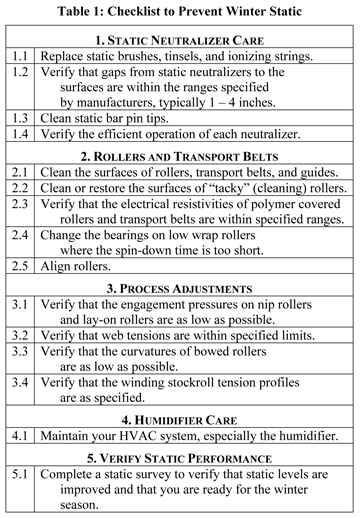Static Beat: Beat Winter Static
- Published: November 23, 2011, By Kelly Robinson
Static becomes worse when the humidity is low. Cold air holds less moisture than warm air. So, the relative humidity of heated air is low, perhaps below 10% on cold days. Table 1 is my “Checklist to Prevent Winter Static” that is an updated version of the one that first appeared in the September 2009 “Static Beat” column. Please feel free to add items that are important to your operations.

1. Static Neutralizer Care
Take good care of your static neutralizers (static bars, ionizing string, etc.) because they are your workhorses for keeping static levels low. Dust and debris on the static bar pin tips degrades their performance. Clean your static bars according to the manufacturer’s recommendations, which is typically to use a soft brush to clean the pin tips. Replace inexpensive static brushes, tinsel, and ionizing strings at least annually.
Measure the gap from each neutralizer to the film surface. Manufacturers typically recommend that static bars should be located 2?4 in. from the film surface. Tinsel and ionizing string should be located 0.5?2 in. from the surface. And, depending on your application, static brushes can be located 0 in. (contacting) ? 1 in. from the surface.
2. Rollers and Transport Belts
Rollers, belts, and guides must be clean because your products accumulate static every time they touch a conveyance element. A thin layer of grease, dirt, or other surface contaminant can greatly increase tribocharging. Cleaning the surfaces can restore good static performance.
“Tacky rollers” (cleaning rollers) are a special case because dust, debris, and contaminants are intended to accumulate on the roller surface. Maintain these rollers according to the manufacturer’s recommendations.
Rubber and polymer surfaces on drive, nip, cleaning, spreader, and lay-on rollers often are sources of sparks because static can accumulate on the surfaces of these rollers. To prevent these sparks, clean these rollers and measure their resistivity. If the resistivity is too high, replace them with static dissipative rollers.
Static is worse when the film slips and slides over low-wrap rollers. Check the bearing drag using a simple spin-down test as described by Tim Walker in his June 2008 “Web Lines” column. The spin-down test itself is simple:
- Drive the roller to a given speed.
- Measure the roller speed with a tachometer.
- Note the speed and start the stop watch.
- Measure the time until the roller stops.
Keep a log of the spin-down times for each of your low-wrap rollers. Shorter times indicate higher bearing drag that can increase risk. If the spin down time is too short, replace the roller bearings.
3. Process Adjustments
Webs that weave or track poorly have many problems including higher static from film slipping over rollers. Solve this by aligning rollers. Similarly, bowed rollers also can generate high static from film slipping over the roller. Check the bow and make sure that it is no higher than needed.
Nip rollers and lay-on rollers can generate high levels of static caused by the high-pressure contact. Check the engagement pressures and nip gaps to make sure that the contact pressure is no higher than necessary.
Maintain film tensions within the range for good conveyance to minimize static. If the tension is too high, the contact pressure between the film and roller surfaces is higher than necessary, which can cause higher static. And, low tension that causes the film to lose traction and weave can cause high static because the film slips and slides over rollers.
The winding tension profile ensures good wound roll integrity, and good control of the tension profile helps minimizes static. Cinching is when the outer surface of one lap slides over the inner surface of the adjacent lap. Cinching can cause high static. And, when the winding tension is too high, contact pressure between the film laps can cause high static.
4. Humidifier Care
Your HVAC system is an important part of your defense against static. Change filters to make sure that the airflow is unimpeded. If your system has a humidifier, service it according to the manufacturer’s instructions. Keeping the relative humidity sufficiently high is a great way to avoid winter static.
5. Verify Static Performance
Once the maintenance and process adjustments are complete, verify static performance by completing a static survey (see K. Robinson, “Static Beat: How to Take a Static Survey,” Paper, Film & Foil Converter, Vol. 84, No. 8, August 2010, p10).
Prevent winter static with good maintenance. Reliable operation during the winter months will be your just reward. I invite you to ask questions about this column and to suggest topics for a future Static Beat. My e-mail address is: Kelly.Robinson@ElectrostaticAnswers.com.













